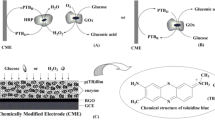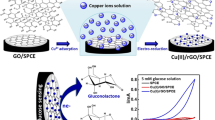Abstract
Enzymes have demonstrated great potential in the development of advanced electroanalysis devices due to their unique recognition and catalytic properties. However, unsatisfactory stability and limited electron communication of traditional enzyme sensors seriously hinder their large-scale application. In this work, a simple and effective method is proposed to improve the stability of enzyme sensors by using sodium hyaluronate (SH) as a protective film, MXene-Ti3C2/Glucose oxidase (GOD) as the reaction layer, and chitosan (CS) /reduced graphene oxide (rGO) as the adhesion layer. Results demonstrate that the repeatability of the designed sensor increased by 73.3% after improving the adhesion between the reaction layer and the current collector and that its response ability was greatly enhanced. Moreover, the long-term stability of the electrode surface with SH protective film proved to be superior than that without protective film, which suggests that this design can effectively improve the overall performance of the enzyme biosensor. This work proposed a multi-tier synergistic approach for improving the reliability of enzyme sensors.

Our proposed protective and adhesion layer can greatly improve the stability of enzyme sensor and realize the rapid detection of glucose in serum sample.






Similar content being viewed by others
References
Lee H, Hong YJ, Baik S, Hyeon T, Kim DH, Glucose E-B, Lee H, Hong YJ, Baik S, Hyeon T, Kim DH (2018) Enzyme-Based Glucose Sensor: From Invasive to Wearable Device. Adv Healthc Mater 7:e1701150. https://doi.org/10.1002/adhm.201701150
Hao S, Zhang H, Sun X, Zhai J, Dong S (2020) A mediator-free self-powered glucose biosensor based on a hybrid glucose/MnO2 enzymatic biofuel cell. Nano Res 14:707–714. https://doi.org/10.1007/s12274-020-3101-5
Bilal M, Iqbal HMN (2019) Chemical, physical, and biological coordination: an interplay between materials and enzymes as potential platforms for immobilization. Coord Chem Rev 388:1–23. https://doi.org/10.1016/j.ccr.2019.02.024
Garcia-Galan C, Berenguer-Murcia Á, Fernandez-Lafuente R, Rodrigues RC (2011) Potential of different enzyme immobilization strategies to improve enzyme performance. Adv Synth Catal 353:2885–2904. https://doi.org/10.1002/adsc.201100534
Liang T, Zou L, Guo X, Ma X, Zhang C, Zou Z, Zhang Y, Hu F, Lu Z, Tang K, Li CM (2019) Rising mesopores to realize direct electrochemistry of glucose oxidase toward highly sensitive detection of glucose. Adv Funct Mater 29:1903026. https://doi.org/10.1002/adfm.201903026
Piotr Mazurek PMZ, Skova AL (2020) Michael A Brook Enzyme Encapsulation in Glycerol–Silicone Membranes for Bioreactions and Biosensors. ACS Applied Polymer Materials 2:1203–1212. https://doi.org/10.1021/acsapm.9b01082
Seelajaroen H, Bakandritsos A, Otyepka M, Zboril R, Sariciftci NS (2020) Immobilized enzymes on graphene as nanobiocatalyst. ACS Appl Mater Interfaces 12:250–259. https://doi.org/10.1021/acsami.9b17777
Wu L, Wu S, Xu Z, Qiu Y, Li S, Xu H (2016) Modified nanoporous titanium dioxide as a novel carrier for enzyme immobilization. Biosens Bioelectron 80:59–66. https://doi.org/10.1016/j.bios.2016.01.045
Kienle DF, Falatach RM, Kaar JL, Schwartz DK (2018) Correlating structural and functional heterogeneity of immobilized enzymes. ACS Nano 12:8091–8103. https://doi.org/10.1021/acsnano.8b02956
Hwang ET, Lee S (2019) Multienzymatic cascade reactions via enzyme complex by immobilization. ACS Catal 9:4402–4425. https://doi.org/10.1021/acscatal.8b04921
Ozawa K, Iwasa H, Sasaki N, Kinoshita N, Hiratsuka A, Yokoyama K (2017) Identification and characterization of thermostable glucose dehydrogenases from thermophilic filamentous fungi. Appl Microbiol Biotechnol 101:173–183. https://doi.org/10.1007/s00253-016-7754-7
Cui H, Zhang L, Söder D, Tang X, Davari MD, Schwaneberg U (2021) Rapid and oriented immobilization of laccases on electrodes via a methionine-rich peptide. ACS Catal 11:2445–2453. https://doi.org/10.1021/acscatal.0c05490
Wu L, Lu Z, Ye J (2019) Enzyme-free glucose sensor based on layer-by-layer electrodeposition of multilayer films of multi-walled carbon nanotubes and Cu-based metal framework modified glassy carbon electrode. Biosens Bioelectron 135:45–49. https://doi.org/10.1016/j.bios.2019.03.064
Goh WJ, Makam VS, Hu J, Kang L, Zheng M, Yoong SL, Udalagama CN, Pastorin G (2012) Iron oxide filled magnetic carbon nanotube-enzyme conjugates for recycling of amyloglucosidase: toward useful applications in biofuel production process. Langmuir 28:16864–16873. https://doi.org/10.1021/la303046m
Li Y, Zhou J, Song J, Liang X, Zhang Z, Men D, Wang D, Zhang XE (2019) Chemical nature of electrochemical activation of carbon electrodes. Biosens Bioelectron 144:111534. https://doi.org/10.1016/j.bios.2019.111534
Weltz JS, Kienle DF, Schwartz DK, Kaar JL (2020) Reduced enzyme dynamics upon multipoint covalent immobilization leads to stability-activity trade-off. J Am Chem Soc 142:3463–3471. https://doi.org/10.1021/jacs.9b11707
Chiu YH, Chen MC, Wan SW (2018) Sodium hyaluronate/chitosan composite microneedles as a single-dose intradermal immunization system. Biomacromolecules 19:2278–2285. https://doi.org/10.1021/acs.biomac.8b00441
Gu H, Xing Y, Xiong P, Tang H, Li C, Chen S, Zeng R, Han K, Shi G (2019) Three-dimensional porous Ti3C2Tx MXene–graphene hybrid films for glucose biosensing. ACS Applied Nano Materials 2:6537–6545. https://doi.org/10.1021/acsanm.9b01465
Shao Y, Yao Y, Jiang C, Zhao F, Liu X, Ying Y, Ping J (2019) Two-dimensional MXene nanosheets (types Ti3C2Tx and Ti2CTx) as new ion-to-electron transducers in solid-contact calcium ion-selective electrodes. Mikrochim Acta 186:750. https://doi.org/10.1007/s00604-019-3878-7
Santana ER, Spinelli A (2020) Electrode modified with graphene quantum dots supported in chitosan for electrochemical methods and non-linear deconvolution of spectra for spectrometric methods: approaches for simultaneous determination of triclosan and methylparaben. Mikrochim Acta 187:250. https://doi.org/10.1007/s00604-020-04225-7
Karaman C, Karaman O, Atar N, Yola ML (2021) Electrochemical immunosensor development based on core-shell high-crystalline graphitic carbon nitride@carbon dots and Cd0.5Zn0.5S/d-Ti3C2Tx MXene composite for heart-type fatty acid-binding protein detection. Mikrochim Acta 188:182. https://doi.org/10.1007/s00604-021-04838-6
Chen X, Qin P, Li J, Yang Z, Wen Z, Jian Z, Zhao J, Hu X, Jiao X (2014) Impedance immunosensor for bovine interleukin-4 using an electrode modified with reduced graphene oxide and chitosan. Microchim Acta 182:369–376. https://doi.org/10.1007/s00604-014-1331-5
Aslan S, Anik Ü (2015) Microbial glucose biosensors based on glassy carbon paste electrodes modified with Gluconobacter oxydans and graphene oxide or graphene-platinum hybrid nanoparticles. Microchim Acta 183:73–81. https://doi.org/10.1007/s00604-015-1590-9
Shahzad F, Alhabeb M, Hatter CB, Anasori B, Hong SM, Koo CM, Gogotsi Y (2016) Electromagnetic interference shielding with 2D transition metal carbides (MXenes). Science 353:1137–1140. https://doi.org/10.1126/science.aag2421
Wang B, Lai X, Li H, Jiang C, Gao J, Zeng X (2021) Multifunctional MXene/chitosan-coated cotton fabric for intelligent fire protection. ACS Appl Mater Interfaces 13:23020–23029. https://doi.org/10.1021/acsami.1c05222
Li L, Fu X, Chen S, Uzun S, Levitt AS, Shuck CE, Han W, Gogotsi Y (2020) Hydrophobic and stable MXene-polymer pressure sensors for wearable electronics. ACS Appl Mater Interfaces 12:15362–15369. https://doi.org/10.1021/acsami.0c00255
Gao Y, Liu G, Bu T, Liu Y, Qi Y, Xie Y, Xu S, Deng W, Yang W, Zhang C (2021) MXene based mechanically and electrically enhanced film for triboelectric nanogenerator. Nano Res. https://doi.org/10.1007/s12274-021-3437-5
Hu D, Wang S, Zhang C, Yi P, Jiang P, Huang X (2021) Ultrathin MXene-aramid nanofiber electromagnetic interference shielding films with tactile sensing ability withstanding harsh temperatures. Nano Res 14:2837–2845. https://doi.org/10.1007/s12274-021-3297-z
Neampet S, Ruecha N, Qin J, Wonsawat W, Chailapakul O, Rodthongkum N (2019) A nanocomposite prepared from platinum particles, polyaniline and a Ti3C2 MXene for amperometric sensing of hydrogen peroxide and lactate. Mikrochim Acta 186:752. https://doi.org/10.1007/s00604-019-3845-3
Yang Q, Yang T, Gao W, Qi Y, Guo B, Zhong W, Jiang J, Xu M (2020) An MXene-based aerogel with cobalt nanoparticles as an efficient sulfur host for room-temperature Na–S batteries. Inorganic Chemistry Frontiers 7:4396–4403. https://doi.org/10.1039/d0qi00939c
Bao S-J, Li CM, Zang J-F, Cui X-Q, Qiao Y, Guo J (2008) New nanostructured TiO2 for direct electrochemistry and glucose sensor applications. Adv Funct Mater 18:591–599. https://doi.org/10.1002/adfm.200700728
Singh E, Meyyappan M, Nalwa HS (2017) Flexible graphene-based wearable gas and chemical sensors. ACS Appl Mater Interfaces 9:34544–34586. https://doi.org/10.1021/acsami.7b07063
Samyn P (2021) A platform for functionalization of cellulose, chitin/chitosan, alginate with polydopamine: a review on fundamentals and technical applications. Int J Biol Macromol 178:71–93. https://doi.org/10.1016/j.ijbiomac.2021.02.091
Mohan K, Ganesan AR, Muralisankar T, Jayakumar R, Sathishkumar P, Uthayakumar V, Chandirasekar R, Revathi N (2020) Recent insights into the extraction, characterization, and bioactivities of chitin and chitosan from insects. Trends Food Sci Technol 105:17–42. https://doi.org/10.1016/j.tifs.2020.08.016
Tao F, Cheng Y, Shi X, Zheng H, Du Y, Xiang W, Deng H (2020) Applications of chitin and chitosan nanofibers in bone regenerative engineering. Carbohydr Polym 230:115658. https://doi.org/10.1016/j.carbpol.2019.115658
Jiang Z, Li N, Li PY, Liu B, Lai HJ, Jin T (2021) One-step preparation of chitosan-based magnetic adsorbent and its application to the adsorption of inorganic arsenic in water. Molecules 26. https://doi.org/10.3390/molecules26061785
Cai CJ, Xu MW, Bao SJ, Ji CC, Lu ZJ, Jia DZ (2013) A green and facile route for constructing flower-shaped TiO2 nanocrystals assembled on graphene oxide sheets for enhanced photocatalytic activity. Nanotechnology 24:275602. https://doi.org/10.1088/0957-4484/24/27/275602
Tan WC, Hofmann M, Hsieh Y-P, Lu ML, Chen YF (2012) A graphene-based surface plasmon sensor. Nano Res 5:695–702. https://doi.org/10.1007/s12274-012-0253-y
Babadi AA, Bagheri S, Hamid SB (2016) Progress on implantable biofuel cell: Nano-carbon functionalization for enzyme immobilization enhancement. Biosens Bioelectron 79:850–860. https://doi.org/10.1016/j.bios.2016.01.016
Kononova SV, Kruchinina EV, Petrova VA, Baklagina YG, Klechkovskaya VV, Orekhov AS, Vlasova EN, Popova EN, Gubanova GN, Skorik YA (2019) Pervaporation membranes of a simplex type with polyelectrolyte layers of chitosan and sodium hyaluronate. Carbohydr Polym 209:10–19. https://doi.org/10.1016/j.carbpol.2019.01.003
Lu S-Y, Lu Y, Jin M, Bao S-J, Li W-Y, Yu L (2017) Design and fabrication of highly sensitive and stable biochip for glucose biosensing. Appl Surf Sci 422:900–904. https://doi.org/10.1016/j.apsusc.2017.06.103
Funding
We appreciate the support from the National Natural Science Foundation of China (no. 21972111, 21773188), Fundamental Research Funds for the Central Universities(XDJK2019AA002, XDJK2019B052), Natural Science Foundation of Chongqing (cstc2018jcyjAX0714), Chongqing Engineering Research Center for Micro-Nano Biomedical Materials and Devices, Chongqing Key Laboratory for Advanced Materials and Technologies, and Venture and Innovation Support Program for Chongqing Overseas Returnees (cx2019073). We also thank Xuelian Yang, Qiuju Yang, and Yuanke Wu for helping with this work.
Author information
Authors and Affiliations
Corresponding author
Ethics declarations
Conflict of interest
The authors declare that they have no competing of interests. This article does not contain any studies with human or animal subjects. Informed consent was obtained from all individual participants include in the study.
Additional information
Publisher’s note
Springer Nature remains neutral with regard to jurisdictional claims in published maps and institutional affiliations.
Supplementary information
ESM 1
(DOCX 548 kb)
Rights and permissions
About this article
Cite this article
Gao, R., Yang, X., Yang, Q. et al. Design of an amperometric glucose oxidase biosensor with added protective and adhesion layers. Microchim Acta 188, 312 (2021). https://doi.org/10.1007/s00604-021-04977-w
Received:
Accepted:
Published:
DOI: https://doi.org/10.1007/s00604-021-04977-w




